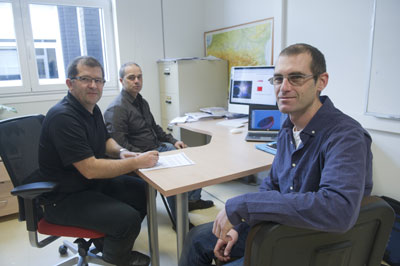| Apr 11, 2013 |
An improved mathematical method for simulating the evolution of the solar system
|
|
(Nanowerk News) In order to improve a simulation designed to study the evolution of the solar system through time, numerical mathematical methods have been developed at the Computing Faculty of the University of the Basque Country (UPV/EHU). Specifically, the methods proposed enable the simulation calculations to be done faster and more accurately.
|
|
The methodology developed at the UPV/EHU's Computing Faculty is a clear example of interdisciplinarity and collaboration. Indeed, mathematicians, computer scientists, physicists and astronomers have been working together on this task, and even though a large proportion of the work was done at the UPV/EHU, the Universities of Valencia and Castellon and the Paris Observatory were also involved.
|
 |
| From left to right, researchers from UPV/EHU Joseba Makazaga, Ander Murua and Mikel Antoñana.
|
|
The mathematician Ander Murua has explained how the collaboration took place. “At the Paris Observatory there is a well-known astronomer by the name of Jacques Laskar who is doing research into the evolution of the solar system. Among other things, Laskar has developed precise mathematical models of the solar system and by using numerical methods in powerful computers, he has made calculations to find out how the solar system has evolved over millions of years. When the astronomical information obtained by Laskar by means of these calculations and simulations is compared with geological data, it is possible to know how changes in the Earth’s orbit are related to glaciations and warming, and this can help to predict what could happen in the future. Both the mathematical model of the solar system and the numerical methods used are important for carrying out these simulations.”
|
|
Laskar’s team did their latest simulation about three years ago and went back 250 million years. It took the computers a whole year to do it. Nevertheless, according to Laskar, even though the results obtained for the last 50 million years are reliable, the ones further back lose reliability because of the chaotic behaviour of the system. Murua says, “Apparently, the next time Laskar does a simulation, he would like to achieve a reliability of the results for a period of 70 million years, by fine-tuning the mathematical model and improving the numerical methods to do the calculations.”
|
|
“That being the case,” adds Murua, “Laskar issued a challenge during a sectoral conference that we held in Castellon”. We had had no contact with Laskar, but through the physicists Fernando Casas and Sergio Blanes of the Universities of Castellon and Valencia, an opportunity presented itself to get in touch with the Catalan Ariadna Farres who works with Laskar." That is how the collaboration started.
|
|
Ten times faster
|
|
The computer scientists Joseba Makazaga and Mikel Antoñana are working together with the mathematician Ander Murua at the UPV/EHU’s Computing Faculty. “We responded to the challenge issued by Laskar and we have improved the numerical methods used in the simulation. Our team has largely been responsible for developing the numerical methods that are more effective than the ones known so far. Firstly, we have achieved greater accuracy, and secondly we have considerably reduced the time needed to do the calculations,” stressed Murua.
|
|
In fact, they have carried out many experiments to verify the validity of the numerical methods they have developed, and they have seen that the simulation can be done ten times faster than with the previous methods. “We don’t know when Laskar is planning to do the simulation again, but when he does, we won’t have to wait a year to find out the results, the work will be completed in a matter of weeks,” he reckons.
|
|
In the meantime, an explanation of the numerical methods developed has been published in the scientific journal Applied Numerical Mathematics in an article entitled "New families of symplectic splitting methods for numerical integration in dynamical astronomy". In addition, Murua has announced that they will also be publishing the results of the comparison between the new methods and the previous ones in the journal Celestial Mechanics and Dynamical Astronomy.
|

